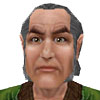Here is Ieaskul F. Mobenthy Sprott, Peter Blasser’s filter for Eurorack. Peter’s manual is, as usual, somewhat abbreviated. I’ve been experimenting with Sprott and herewith are some of my findings.
Peter describes the module as:
The Sprott module is a model of chaotic jerk system with standardized voltage control of all parameters. Thus, the chaotic attractor can be shrank down to distill the module into a resonant filter that is the dynamical sub- circuit underlying most jerk systems. It is named after J.C. Sprott who has published numerous papers, articles and books on chaos and chaotic circuits, from a rigorous physical view-point.
Inputs and Outputs
The arrangement of the panel is deceptively symmetrical. It looks like four similar sections, one above the other. However, they are not perfectly related. There are four signal inputs and four signal outputs, aligned with each other. From top to bottom:
- High pass input and output
- Band pass input and output
- Low pass input and output
- Chaos pass input and output
High Pass VCA Controls
The top section, aligned with the HP input and output, has the controls over a VCA on the HP input. There is the initial level knob, a CV input with attenuverter knob, and a ‘diode’ input, which is a second CV input. All of these controls impact the VCA going to the HP input. The initial knob is fully off when counter-clockwise to the left and fully on to the right. Note that these controls over the VCA will have no impact on the outputs, unless there is something patched to the HP input.
Resonance Controls
The second section, aligned with the BP input and output, has the Q controls, which impact all the outputs. There is the initial Q knob, a CV input with attenuverter knob, and a ‘diode’ input, which is a second CV input. The minimum Q is the position fully clockwise, to the right, which seems non-intuitive. The range switch just above impacts the BP section.
Center Frequency Controls
In the third section, aligned with the LP input and output are the frequency controls. These impact all the outputs. There is the initial center frequency knob, a CV input with attenuverter knob, and a ‘diode’ input, which is a second CV input. The range switch just above impacts the LP section.
Chaos Controls
The bottom section, aligned with the CP input and output, has the controls over chaos. These impact all the outputs. There is the initial chaos knob, a CV input with attenuverter knob, and a ‘diode’ input, which is a second CV input. The range switch just above impacts the CP section.
Signal Flow
Because Sprott has four signal inputs and four signal outputs, if you want to process a single audio signal, you have 16 choices of signal path. Each input produces a signal on all four outputs. And each combination has a different sound to it. You can also patch into more than one input at the same time. The sample recordings, below, will demonstrate some of these.
Diode Inputs
Peter says these are the ‘least explainable’. They are secondary CV inputs, one for each section, and seem to respond only to positive CV. They don’t seem to pass a signal. Try patching a positive DC bias here, and experiment with how it alters the sound. Enough said.
Levels, Q, Chaos, and Grunginess
Sprott wants to get grungy. The outputs will get very large and even clip at the power rails levels, when the combination of Q and Chaos are high enough. Self-oscillation is possible, but is chaotic. It can die out unexpectedly. Chaos contributes to self-oscillation possibilities, leading to it even when Q is minimized. Tip: Jogging the Chaos range switch can kick start the chaos, or kill it off. Here’s an example of self-oscillation, with no signal inputs, but with an envelope into the FM CV input. I twiddle with the Q and Chaos knobs.
Range Switches
The range switches, from top to bottom, impact the BP, LP, and CP sections, respectively. Yes, they do impact all of the outputs. For audio signal processing it’s best to leave the BP and LP toggles in the middle, for audio rate. However, the CP range toggle can be useful in different positions when processing audio.
Sub-audio Processing
Sprott can be used at very low frequencies, as a kind of slew limiter. The following demonstrates control over the frequency of a Denum oscillator by a cycling Swoop being processed through Sprott’s HP input to the LP output. Twiddling with knobs.
Examples
Typical low pass filter usage: Patch to HP input, listen to LP output. This example uses a signal made by ring modulating together two Denum oscillators. I manually twiddled knobs.
Demonstrating low pass filtering with high Q. Cycling envelope on FM CV input. Input is a single Denum oscillator triangle wave, at a fixed pitch.
Mixing two Denum oscillators, one into HP and one into LP inputs. Listen to LP out. Has a cycling Swoop envelop on the FM CV input. Knob twiddling.
Band pass input and output, with added chaos. Also using an envelop to the FM CV input.
Filtering a very low frequency (<10 Hz) square wave to the LP input. First hear dry signal, then in succession the HP, BP, and LP outputs. With varying amounts of Q. Modulated by a slowly falling envelope on the FM CV input.
Demonstrating the Chaos Pass input, listening successively to the HP, BP, LP and CP outputs. Signal in is the two ring modulated Denum oscillators. Manually sweeping the center frequency.
Demonstrating modulating the Chaos CV with cycling envelope and manually varying the center frequency. Not sure which output this was.



It seems like when I patch the BP out to HP In , the self oscillation stay always firm.
Presumably the circuit has been modified over the years as on my unit the Q pot shows traditional behaviour (fully clockwise = maximum resonance).
A great filter.